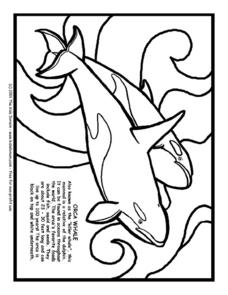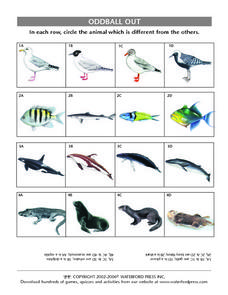University of Maryland
Pollination
Sixteen ounces of honey requires more than 1,000 bees traveling over 100,000 miles and visiting 4.5 million flowers. The presentation includes sexual reproduction in plants, the parts and functions of a flower, pollination,...
Curated OER
Who Am I?
Young biologists can see a variety of animals, amphibians, mammals, insects and clearly identify them. They match up the animals' names with the picture. The pictures are clear and colorful! A very nice worksheet for early elementary...
Purdue University
The Great Clearcut Controversy
Urban development and habitat retention are often at odds. A three-part lesson examines the pros and cons of forest clearcutting. Learners review data and characteristics of a specific mammal to make conclusions about the effect...
Curated OER
Orca Whale Information and Coloring Page
In this animal information and coloring page, students read a short factual paragraph about Orca whales before coloring a picture of the mammal in its habitat.
Discovery Education
Sonar & Echolocation
A well-designed, comprehensive, and attractive slide show supports direct instruction on how sonar and echolocation work. Contained within the slides are links to interactive websites and instructions for using apps on a mobile device to...
Curated OER
Animal Classification
Students recognize the six groups of animals (Mammals, fish, birds, reptiles, amphibians and arthropods) and their characteristics. In this animal characteristics lesson, students sort animals by their traits. Students cut and paste...
Curated OER
Desert Animals
Students survive within an ecosystem, an animal must be physically and behaviorally adapted to the conditions of its environment.
Curated OER
Transgenic Mammals
Students are provided with a real life example of research in the areas of genetic and molecular biology. Students examine ethical considerations and related issues such as patent laws and regulatory procedures.
Curated OER
Investigation 10 - Mammal Oral Reports
Fourth graders research a Utah mammal, then create and present a mini-report. They access websites imbedded in this plan to help them with their research. There is also a nice prewrite graphic organizer to help them organize their...
Curated OER
Mammals- Picture Cut and Paste
In this science worksheet, students cut out and paste clip art pictures of animals. They paste the pictures of mammals in the box at the bottom of the page.
Curated OER
Animals That Begin With...
In this animal names worksheet, students follow directions to name animals that begin with various letters of the alphabet. A website reference for additional resources is given.
Curated OER
Learning About Mammals
Students study the mammal classification and forms of them living in the United States. For this mammal study lesson, students read through orders of mammals that exist in the United States. Students also study the taxonomy of an eastern...
Curated OER
Meet My Mammal
Learners create a multimedia presentation about a mammal of their choice. They develop a new presentation document and all slides within the presentation. They share the information about their animal with the class.
Curated OER
Endangered Mammals: African and Asian Elephants
Young scholars explore the concept of endangered mammals. In this elephants lesson, students research Internet resources regarding African and Asian elephants.
Curated OER
Animals at Night
In this nocturnal animals activity, students study a fact page with lists of mammals, insects, birds and amphibians that they may see on the school grounds at night. There are no questions to answer.
Curated OER
Oddball Out: Birds, Fishes, Marine Mammals
In this science worksheet, pupils analyze 4 animal pictures in a row. Students circle the animal which is different from the others. There are 4 rows of pictures. Answers are provided upside down at the bottom of the page.
Curated OER
Animals of Point Reyes
Seventh graders explore how disasters affect animals. In this animal habitats lesson students create an animal that will survive in Point Reyes habitats.
Curated OER
Where Do Animals Come From?
Students use library search engines to research an animal and its origin. In this animal research lesson, students research their assigned animal using ProQuest. Students then find the country of origin of the animal using a library...
Curated OER
Mammal Morphology - Bats, People, and Other
In this physical characteristics worksheet, students compare bats and humans by putting a + sign in the chart for whether or not bats and humans have the same characteristics. Students do this for 17 characteristics and answer 3 questions.
Curated OER
Sea Otters--Funny Mammals of the Sea
In this sea otters worksheet, students read a 2 page article on sea otters, define 12 vocabulary words from the article and answer 7 comprehension questions in complete sentences.
Michigan State University
Friend or Foe?
What one person thinks is a pest may not be a pest to someone else. Here, scholars examine the characteristics of living things and pests through grand conversation and a variety of activities. Class members play a game of pest or not a...
Curated OER
Exploring Ecosystems
Students examine the relationships between plants, animals, and the environment in ecosystems. They sort animal cards, collect natural materials from the schoolyard, and record an ecosystem web in the form of a poster.
Curated OER
Animal Categories
Students sort animal picture cards into classification groups such as mammals, reptiles, amphibians, insects and fish. They discuss the characteristics that each group of animals shares then arrange the pictures into a clasificatioon...
Curated OER
The Ocean
Plant and animal life of the ocean is the focus of this science lesson. Young scientists sort a variety of seashells and explore why many sea animals have shells. They examine the shells, write journal entries highlighting the...

























